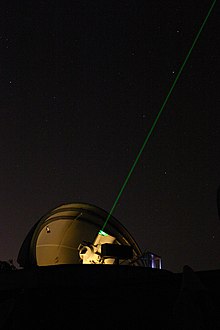Laser telescope

Laser telescope is the abbreviation for a telescope with a photoelectric receiver that is used for laser distance measurements to earth satellites ( Satellite Laser Ranging , SLR) and to the moon ( Lunar Laser Ranging , LLR).
These are mostly reflector telescopes with 40 to 80 cm aperture and a few meters focal length. In instruments of the 3rd and 4th generation (since around 1990) the same optics are used to transmit and receive the laser beams . These rays are reflected in the direction of origin by triple mirrors on the satellite ; their running time results in twice the distance to the satellite.
The two beam paths are separated by means of a semi-transparent mirror , and the electronic switchover between transmit and receive mode is based on the gate time - the short period of time after which the reflected signal can be expected at the earliest. With earth satellites the gate time is a few milliseconds, with the moon 2.5 seconds.
Older devices had their own transmission optics for the laser.
The measuring telescopes of modern theodolites and total stations are also small laser telescopes with which the distances to measurement points can be determined in a similar way . Due to the lower laser intensity (range approx. 200 to 2000 m distance), the direction measurement (visual eyepiece + thread network), the laser and its receiving optics can be accommodated coaxially in the measuring telescopes, which are only 10–15 cm long.
Special applications of small laser telescopes are alignment and channel lasers as well as laser trackers .
See also
- Satellite observation
- Microwave systems, Sequential Collation of Range (SECOR)
- Satellite telescope
